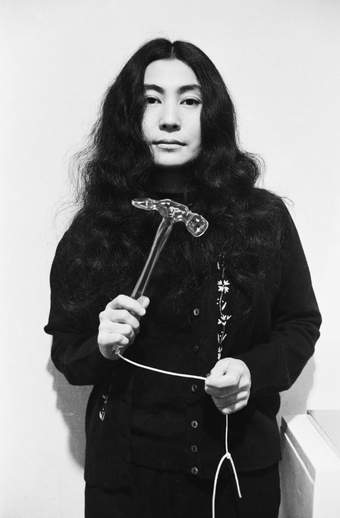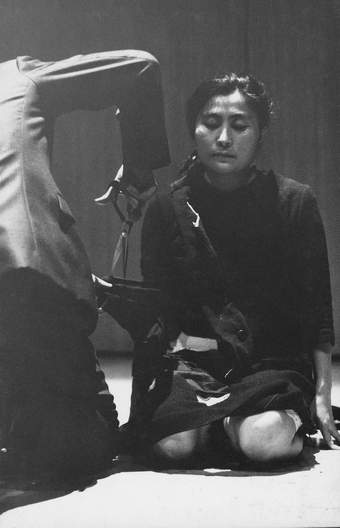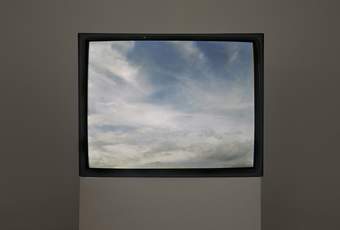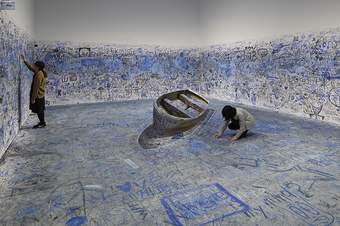
Yoko Ono with Glass Hammer 1967 from HALF-A-WIND SHOW, Lisson Gallery, London, 1967. Photograph © Clay Perry / Artwork © Yoko Ono
Find out more about our exhibition at Tate Modern

Yoko Ono with Glass Hammer 1967 from HALF-A-WIND SHOW, Lisson Gallery, London, 1967. Photograph © Clay Perry / Artwork © Yoko Ono
YOKO ONO: MUSIC OF THE MIND celebrates the work of artist and activist Yoko Ono (born 1933). The exhibition explores Ono’s conceptual practice, foregrounding ideas over objects, alongside her ongoing campaign for world peace. It takes its title from the artist’s desire to stimulate the imagination. Ono notes, ‘The only sound that exists to me is the sound of the mind. My works are only to induce music of the mind in people … In the mind-world, things spread out and go beyond time.’
The exhibition traces Ono’s radical approach to art, language and participation, from her early ‘instruction’ pieces to her recent, large-scale installations. It covers seven decades of Ono’s expansive practice, from 1955 to today. During this time, Ono moved between Japan, the US and the UK, before settling in New York in 1971. Following a loose chronology, the exhibition highlights recurring ideas and themes in Ono’s work, making connections across time and place. Ono’s art takes many forms. It includes scores, performances, objects, film, music, sound and events. In 1964, Ono published Grapefruit, her foundational book of instruction works. These concise texts, somewhere between poem and score, aim to unlock the mind. Instructions are presented throughout the exhibition, calling you to participate, often with others.
Ono invites you to realise her artworks – to construct paintings in your mind, perform inside a bag, play a game of chess and share your memories and wishes. But, most importantly, Ono invites you to imagine. This collective call to action is a provocation to change the world, one wish at a time.
A dream you dream alone is only a dream.
A dream you dream together is reality.
Yoko Ono
As part of YOKO ONO: MUSIC OF THE MIND, works by Ono are presented across Tate Modern. You are invited to share your wishes for peace on Wish Trees for London directly outside the exhibition. Find Ono’s instruction Painting to Be Constructed In Your Head (‘Observe three paintings carefully. Mix them well in your head.’) in the free collection displays. PEACE is POWER is presented on the windows of the Restaurant on Level 6 of the Natalie Bell Building.
Yoko Ono spent most of her childhood in Tokyo, Japan, also living for short periods in the US. Music and performance were an important part of Ono’s family life and early education. She studied classical music and learnt how to translate everyday sounds into musical notation.
In spring 1945, during the Second World War, US Army Air Forces bombed Tokyo. Ono, aged 12, was evacuated to the countryside, where food and other essentials were in short supply. Ono and her younger brother, Keisuke, would lie on their backs, look up at the sky and escape in their imaginations. She remembers, ‘we exchanged menus in the air and used our powers of visualization to survive’. Ono describes this as ‘maybe my first piece of art’.
In August, the US Army dropped the first atomic bombs on the cities of Hiroshima and Nagasaki, bringing about Japan’s surrender and ending the war. Ono notes that ‘those experiences of the early days cast a long shadow in my life’.
Following the end of the war, Ono returned to Tokyo, later attending Gakushūin University as its first female philosophy student. She left after two semesters to join her parents in New York State. In 1953, she enrolled at the liberal arts college Sarah Lawrence, studying poetry and musical composition. During this period, Ono developed some of her earliest instructions. These include Lighting Piece – ‘Light a match and watch till it goes out’.
This gallery presents three expressions of Lighting Piece: the instruction, a performance and a film. Together, they reveal Ono’s ongoing process of interpreting, realising and imaginatively transforming ideas. Specific actions, words, imagery and themes recur across her practice and echo throughout the exhibition.
In 1956, aged 23, Ono moved to New York City, eloping with Japanese composer and pianist Toshi Ichiyanagi (1933–2022). In 1960, she began renting a loft at 112 Chambers Street in Lower Manhattan. Ono and composer La Monte Young (born 1935) programmed concerts and events there, providing a forum for artists, musicians, dancers and poets. Ono performed in other artists’ concerts and installed her instruction-based paintings for the first time.
In July 1961, Ono’s first solo exhibition opened at AG Gallery in Manhattan. Paintings & Drawings by Yoko Ono included more than fifteen Instruction Paintings which were realised through the participation of the artist, visitors or the environment. A few paintings had written instructions, but Ono communicated most by word of mouth. AG Gallery was owned by architect and designer George Maciunas (1931–1978), who later founded Fluxus. An international network of artists and composers, Fluxus opened up definitions of what art could be, promoting ‘living art, anti-art’. Ono played an active role in the formation of this loose collective and later participated in Fluxus performances and events.
Less than a year later, Ono exhibited more than thirty instructions for paintings at her exhibition at Sogetsu Art Center, Tokyo. This time, her words were presented without accompanying canvases. It marked a decisive conceptual shift in her practice and the history of ideas-based art. Paint was replaced by language and the viewer ‘completed’ the artwork, either physically or simply in their mind. The idea took primacy over the object.
During this period, Ono performed a series of concerts and events in both New York and Tokyo. She invited other artists to join her in these highly experimental interpretations of her instructions. The resulting performances combined poetry, atonal music, vocalisation and amplified sounds.
Ono travelled to Tokyo in 1962 and ended up staying for two years. During this time, she connected with many artists, some of whom she had already met in the US. She was part of an artistic community challenging and subverting mainstream culture.
Ono joined Ichiyanagi, who had arranged an exhibition and concert titled Works of Yoko Ono at Sogetsu Art Center, Tokyo. She displayed her Instructions for Paintings in the lobby next to the concert hall. Thirty prominent members of Tokyo’s avant-garde performed in the concert. Ono instructed the audience to seek out kehai (vibration), look into their inner worlds and focus on their senses. Ichiyanagi and Ono also organised and participated in a Japanese concert tour with two US composers and experimental musicians: John Cage (1912–1992) and David Tudor (1926– 1996). Ono presented bold interpretations of Cage’s pieces.
During this period, Ono met and married US filmmaker Anthony Cox (born 1937). Between 1963 and 1967, Cox helped produce and promote Ono’s activities in Tokyo, New York and London. In 1964, Ono presented Contemporary American Avant-Garde Music Concert: Insound and Instructure at Yamaichi Hall, Kyoto. As part of the concert, Ono performed Cut Piece for the first time. She sat silently onstage wearing her best suit while the audience cut away pieces of her clothing.
Before returning to New York in 1964, Ono held a farewell concert at Sogetsu entitled Strip Tease Show, featuring Cut Piece, Bag Piece and Striptease for Three. To ‘strip’, she explains, means ‘not to reveal to others’ but to ‘discover something hidden in humans’ and a ‘stripping of the mind’. The idea of exploring one’s self united many of the pieces Ono presented at her Japanese concerts.

Yoko Ono Cut Piece 1964, photographed 11 August 1964, printed 2024 Performed by Yoko Ono in Yoko Ono Farewell Concert: Strip Tease Show, Sogetsu Art Center, Courtesy the artist © Yoko Ono Photograph by Minoru Hirata
Ono and Cox’s daughter, Kyoko, was born in Tokyo in 1963. During this time, Ono continued creating instructions and performed some of them in public. In 1964, she published Grapefruit through her own imprint, Wunternaum Press. It includes more than 200 instructions divided into five sections: MUSIC, PAINTING, EVENT, POETRY and OBJECT. Each instruction is dated by the year of its conception, from 1953 to 1964.
The grapefruit is a recurring motif for Ono. She notes, ‘I named my first book of instructions with the name of the fruit I loved. Grapefruit is a hybrid of orange and lemon and to me, it represented East and West, the two cultures in my life.’ The fruit began as a cross between a sweet orange and a pomelo. For Ono, it reflects her identity as a ‘spiritual hybrid’ and of never feeling at home, either in Japan or the US.
Ono’s instructions can be completed by anyone, some physically, some only in the mind. They act like musical notation that can be played by anyone to create their own work. Ono performed them many times, collaborating with artists and musicians across Japan and the US at small participatory events and major concerts.
Ono also presented her conceptual works for sale, offering a playful critique of the commercial art world. She staged events in Japan and New York where she sold shards of broken glass labelled with future dates. She also created Ono’s Sales List, a mail-order catalogue of both physical and conceptual works. These included recordings of the sound of snow falling, touch poems, and works that were never made, such as the book Grapefruit II.
This gallery brings together works and performances Ono made in England between 1966 and 1971. During her five-year stay here, Ono connected with artists, musicians and writers, including musician John Lennon (1940–1980), her future husband and long-term artistic partner.
In September 1966, Ono was invited to take part in the Destruction in Art Symposium in London. Ono performed several works and gave a talk outlining the fundamentals of her participatory art. They can be summarised as: event-based; engaged with the everyday; personal, partial or presented as unfinished; a catalyst to creative transformation; and existing within the realm of the imagination.
In November that year, Ono opened a solo exhibition at Indica Gallery in London. She exhibited mostly white and transparent objects that were listed as ‘unfinished’. Many works were accompanied by an instruction inviting audiences to complete them in their imagination. Ono also supplied materials, allowing visitors to physically complete others.
In the context of the US civil rights movement, second-wave feminism and growing opposition to the American War in Vietnam (1955–1975), Ono’s campaigning work gained mainstream interest. Working in collaboration with Lennon, Ono used her art and global media platform to advocate for humanitarian causes and world peace. In the late 1960s, they wrote to world leaders, created billboard campaigns, recorded songs and staged Bed-In events. Their message of nonviolence resounded in their song ‘Give Peace a Chance’, which became an anthem of the international peace movement.
This listening space presents a selection of album covers for records released between 1969 and 2018, alongside a curated playlist.
Ono began exploring the voice as an instrument during a series of radical performances in New York in the early 1960s. The tracks included here highlight Ono’s innovative approach to music and sound. They feature open-ended structures, improvised vocals, outtakes and sounds effects.
Between 1968 and 1973, Ono’s musical output was prolific. She released music as a solo artist and together with Lennon, including as Plastic Ono Band. A trio of albums produced by Ono and Lennon in the late 1960s – Unfinished Music No.1: Two Virgins, Unfinished Music No.2: Life with the Lions and Wedding Album – reflect their lives and artistic partnership. Ono notes: ‘we crossed over into each other’s fields, like people do from country music to pop. We did it from avant-garde left field to rock ’n’ roll left field. We tried to find a ground that was interesting to both of us. And we both got excited and stimulated by each other’s experiences.’
Many tracks connect directly to Ono’s artworks and amplify her activist priorities. Some explicitly refer to Grapefruit instructions and many reference her engagement with women’s liberation. Feminist anthems from the early 1970s to the mid-1990s, including ‘Sisters, O Sisters’, ‘Woman Power’ and ‘Rising’, seek to empower women to ‘build a new world’, ‘have courage’ and ‘rage’.
Like all her work, Ono’s music is uncompromising and outspoken. She explores social and political issues as well as her personal experiences. Her 1981 album, Season of Glass, produced following Lennon’s assassination in December 1980, is a deeply emotional and public response to her husband’s death. Ono comments, ‘that was the reason I survived, I think – it was the music that made me survive’.
In the room to your left, Ono’s 24-minute film FLY and one-minute film Freedom are screening continuously, one after the other.
Ono and Lennon settled in New York at the start of the 1970s. They continued to collaborate on projects and both FLY and Freedom were made during this time. Ono has long explored the dynamics of power, vulnerability and violence in her art and music. In these films, she engages with the US women’s liberation movement of the late 1960s and 1970s. Second-wave feminism moved beyond the first-wave focus on suffrage, advocating for far greater societal change. For Ono, this includes explorations of power structures, women’s oppression and role in society, discrimination and the nature of equality.
FLY is based on Ono’s 1968 score Fly (Film No.13), which reads, ‘Let a fly walk on a woman’s body from toe to head and fly out of the window’. It features actress Virginia Lust, real flies ‘supplied by New York City’ and a multi-layered soundtrack that mixes Ono’s voice with guitar instrumentals by Lennon. Ono describes both the woman’s body and the fly as representations of herself. The fly carries associations of dirt and decay while also embodying the concept of a free spirit. Ono frequently explores flight as a physical act and a metaphorical concept. Both act as symbols of liberation and empowerment.
Freedom depicts Ono striving to break free from her bra. The film acts as a commentary on women’s struggle to escape societal constraints. Shortly after making the film, Ono wrote her 1971 manifesto, The Feminization of Society, noting: ‘If we try to achieve our freedom within the framework of the existing social set-up, men, who run the society, will continue to make a token gesture of giving us a place in their world.’

Yoko Ono, FLY 1970-71. Courtesy the artist
This room brings together works from the mid-1960s to 2009. They reveal Ono’s use of the sky as a metaphor for freedom and limitlessness, her ambition to heal the self and the world, and her message of peace.
In 1983, Ono placed an advert in the New York Times that took the form of an article titled ‘Surrender to Peace’. She wrote: ’Our purpose is not to exert power but to express our need for unity despite the seemingly unconquerable differences. We as the human race have a history of losing our emotional equilibrium when we discover different thought patterns in others. Many wars have been fought as a result. It’s about time to recognize that it is all right to be wearing different hats as our heartbeat is always one.’
The concepts of trauma and healing run consistently throughout Ono’s practice. As a child fleeing the bombing of Tokyo during the Second World War, Ono found comfort in the constant presence of the sky. She remembers: ‘Even when everything was falling apart around me, the sky was always there for me … I can never give up on life as long as the sky is there.’
Ono is deeply critical of violence, believing the world can start to heal if violence is confronted. Much of her work is an invitation to see the world differently, from another perspective. This approach is encapsulated in a work like A HOLE (in the centre of this room). A pane of glass shot by a bullet reads: ‘Go to the other side of the glass and see through the hole.’

Yoko Ono SKY TV 1966, exhibition realisation 2024 Courtesy the artist © Yoko Ono
Add Colour (Refugee Boat) begins as an all-white boat in an all-white room. Ono’s instruction for this collective, participatory work reads: ‘Just blue like the ocean.’ You are invited to contribute your hopes and beliefs in blue and white.
Ono conceived the work after being moved by international press coverage of the hundreds of thousands of refugees risking their lives to travel to Europe by sea. This participatory work invites you to reflect on this urgent and ongoing refugee crisis. The United Nations Refugee Agency predicts that, in 2024, the number of people across the world forcibly displaced and stateless will rise to more than 130 million.
Ono made her first Add Colour work at her Chambers Street loft in 1961, splattering sumi ink onto a long stretch of raw canvas. She developed the idea in 1966, at Indica Gallery in London, inviting her audience to add colours to small blank canvases to make a collective work of art. With Add Colour (Refugee Boat), Ono invites us to consider the impact collective action can have. The work encapsulates her belief in human agency and her understanding that ‘we are sharing this world’ and sharing our responsibility for it.

Yoko Ono Add Colour (Refugee Boat) concept 1960, first realised 2016, installed at Yoko Ono Learning Garden of Freedom, Fondacao de Serralves – Museu de Arte Contemporanea, Porto, Portugal, 30 May–15 November 2020. Courtesy the artist © Yoko Ono Photograph by Filipe Braga
The final room of the exhibition brings together two works that reveal Ono’s use of personal experiences and reflection to encourage collective responses. My Mommy is Beautiful is a two-part work exploring our relationship to our mothers. Suspended at height, a series of photographs embody Ono’s humour and humanity. She comments: ‘one has to look up at the vagina and the breasts on the ceiling – rather like looking up at your mom’s body when you are a baby.’ Ono invites you to: ‘Write your thoughts of your mother. Or pin a photograph of her to the canvas.’ The hope is that the work evolves over the course of the exhibition as an intimate homage to mothers. Ono states that all her work ‘is a form of wishing’. The exhibition closes with WHISPER, performed by Ono in her eightieth year. The artist’s powerful vocals repeat the words ‘I wish … let me wish’. For Ono, our most important wish is one for peace. In Ono’s words:
Power works in mysterious ways. We don’t have to do much.
Visualize the domino effect and just start thinking PEACE.
Thoughts are infectious. Send it out.
The message will circulate faster than you think.It’s Time for Action.
The Action is PEACE
Think PEACE, Act PEACE, Spread PEACEIMAGINE PEACE
PEACE is POWER!
Yoko Ono
Need a bigger font size of the exhibition guide? Download the large print guide [0.50MB]